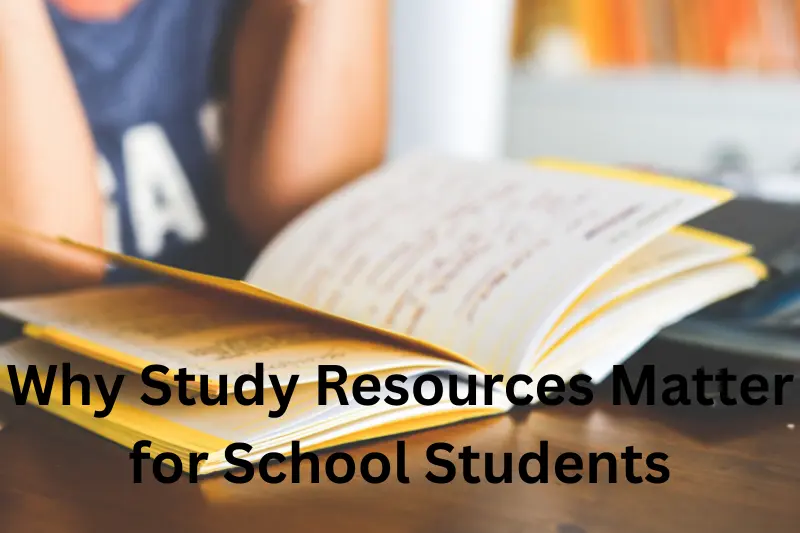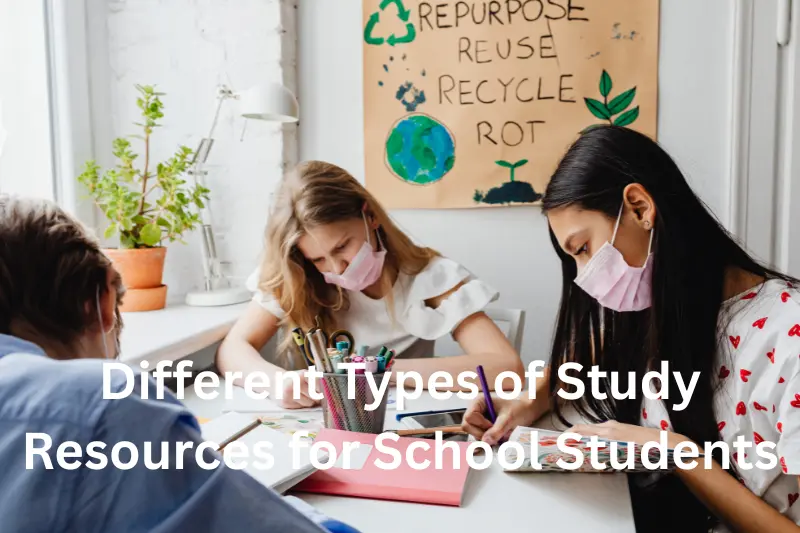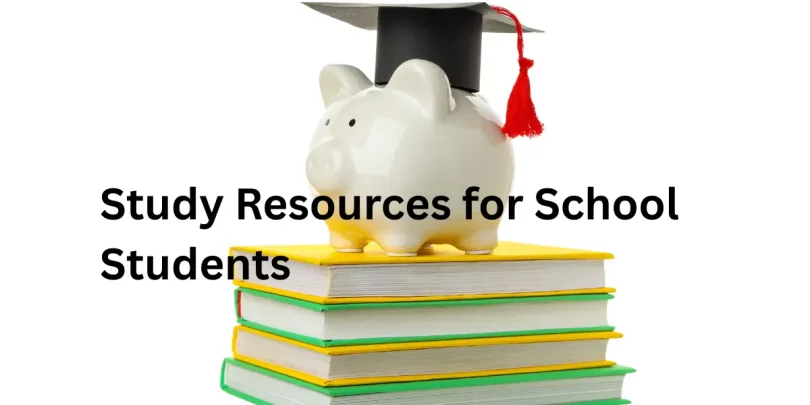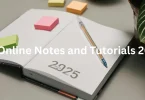We’ve all been there—you sit down to study, open your notebook, and stare blankly at the page, wondering where to start. You flip between textbooks, YouTube videos, and random websites, hoping something will finally click. It can be overwhelming, right? That’s where study resources for school students come in. They’re like your academic best friends—always ready to help you understand concepts, prepare for exams, and make studying way less stressful. Let’s be honest: studying isn’t always fun. Sometimes it feels like a never-ending cycle of notes, assignments, and tests. But here’s the deal—when you have the right study resources, the whole learning process becomes smoother, more enjoyable, and even exciting. Whether you’re a student trying to catch up, a parent looking to guide your child, or a teacher searching for better tools, this guide will walk you through everything you need to know about using and finding the best study resources that actually work.
Why Study Resources Matter for School Students

Here’s some real talk—study resources aren’t just “extra stuff” to read. They’re essential for learning in today’s world. Traditional textbooks are great, but they can’t cover everything in an engaging way. Sometimes you need visuals, practice materials, and digital tools to make sense of what you’re learning. When students have access to the right combination of study materials, they can bridge the gap between simply memorizing information and truly understanding it. Study resources are designed to cater to different learning needs, helping students grasp complex ideas through practical examples and interactive formats. These resources help school students understand difficult topics more easily, stay organized, practice regularly, and identify their weak areas. They also help in building confidence, especially before exams. Instead of feeling anxious, students feel prepared because they’ve spent time reviewing concepts in different formats—videos, worksheets, and even online quizzes. With the right study tools, students transform into independent learners who take charge of their education rather than waiting for someone else to guide them.
The Common Struggles Students Face While Studying
Before we dive into how to find the right resources, let’s talk about the real struggles that students face every day. Many students find it hard to stay focused or motivated when studying. They might not know where to begin, or they may feel overwhelmed by the sheer amount of material they need to cover. Some students lose focus because they’re bored or distracted, while others struggle with specific subjects that don’t make sense no matter how many times they read the same paragraph. The problem isn’t always with the student—it’s often that they haven’t found the right study method or material that fits their learning style. Imagine a visual learner trying to study only through text-heavy books or an auditory learner relying solely on diagrams. It just doesn’t work. That’s why choosing the right type of study resource can make all the difference in how well students understand and retain information. The goal is not just to study harder, but smarter.
Different Types of Study Resources for School Students

Now let’s talk about the types of study resources available and how they can help. Not all study resources are created equal, and every student learns differently. The beauty of having multiple study options is that you can mix and match what works for you. Textbooks and reference books are the foundation of learning. They’re essential for understanding your school curriculum. But relying only on them can make studying dull. Supplementing textbooks with guides, workbooks, and solution manuals can make studying more dynamic. Then there are online study platforms—these have revolutionized learning. Websites and learning apps like Khan Academy, Byju’s, or Coursera offer interactive lessons, quizzes, and personalized learning paths. They make studying feel like an adventure instead of a chore. Study apps and tools such as Quizlet or Notion make organizing your notes simple and fun. You can set reminders, create flashcards, and even share study materials with friends. Video tutorials are another great tool. Watching someone explain a difficult topic step-by-step makes it easier to grasp complex subjects. It’s like having a personal tutor available anytime. Finally, printable worksheets and mock tests are invaluable for practice. These materials give students hands-on experience, helping them test their understanding and track progress before exams.
Choosing the Right Study Resource for You
Now that you know there are so many options out there, how do you choose the right one? Here’s the no-fluff truth—it’s all about understanding yourself first. Every student has a unique learning style. Some students are visual learners—they remember things best when they see them in charts, videos, or pictures. Others are auditory learners, who prefer to listen to explanations or discussions. Then there are kinesthetic learners, who learn through physical activities or hands-on practice. Recognizing your learning style is the first step. Once you know how you learn best, finding the right study resources becomes much easier. Another important factor is matching your study materials with your curriculum. Not every website or app will follow your school’s syllabus, so it’s important to double-check before diving in. It’s also tempting to try every new app or platform, but that can backfire. Too many tools can be overwhelming. Stick with two or three reliable ones that truly help you progress. Quality always beats quantity when it comes to studying.
You may also like to read these articles
Unlock Your Potential with the Best Skill Development Courses Online
Unlock Your Potential with Practical Skill Development Programs
Unlock Future Success with Skill Development for Students
Transform Your Career with Expert Professional Skill Building Tips
Unlock Your Confidence: how to improve communication skills Fast
How to Use Study Resources Effectively
Finding the right study materials is just one part of the equation. The next step is learning how to use them effectively. Before you start studying, set a clear goal for each session. Maybe you want to finish a chapter, practice equations, or summarize a lesson. Having a specific goal keeps you focused and helps you measure your progress. Create a study routine that works for you. It doesn’t have to be long or complicated—a consistent schedule is what really matters. Divide your subjects into smaller chunks so you can tackle them one at a time. Consistency beats marathon study sessions every single time. While studying, take notes in your own words. Don’t just copy what you read or hear—summarizing helps you process information better. Review your notes regularly, and test yourself using flashcards or quizzes. Self-testing isn’t just about checking what you know—it’s about strengthening your memory and understanding. Finally, stay consistent. Even a short daily study habit can make a huge difference in the long run.
The Role of Parents and Teachers in Providing Study Resources
Parents and teachers are the pillars of support for every student. They can guide, motivate, and ensure that students have access to the right study resources. Parents can help by setting up a quiet and comfortable study environment at home. They can encourage healthy study habits, recommend trustworthy online platforms, and check in regularly to track progress. A simple conversation about what their child is learning can boost confidence and motivation. Teachers also play a critical role. They can identify where students are struggling and recommend specific materials that address those gaps. Teachers often have access to digital resources, reference books, and worksheets that align with the school curriculum. When parents and teachers work together, students get the perfect balance of structure and support, helping them learn more effectively.
Free and Reliable Study Resources Online
Let’s face it—not every student can afford expensive tutors or paid study materials. The good news is that there are countless free and high-quality study resources available online. Many educational websites provide lessons, practice tests, and e-books that follow school syllabuses. You can find government portals offering free academic materials, or open educational resources created by teachers around the world. YouTube is another goldmine for learning. You can find step-by-step explanations of math problems, science experiments, or even grammar lessons—all for free. These resources not only make learning affordable but also accessible to anyone with an internet connection. The key is to choose reliable platforms with credible information. Free doesn’t mean low quality—you just need to know where to look.
How Study Resources Build Confidence
Confidence is one of the most underrated benefits of using good study resources. When students can understand a topic they once struggled with, their self-belief skyrockets. Study resources offer different ways to approach learning, allowing students to find methods that suit them best. Over time, this builds a sense of control and accomplishment. For instance, a student who was once scared of math might gain confidence by practicing regularly with digital quizzes or worksheets. Another who struggled with science could start enjoying it after watching simple, engaging video explanations. Confidence also helps students stay motivated. Once they see their hard work paying off through better understanding or improved grades, studying becomes a positive experience rather than a stressful one.
Common Mistakes to Avoid When Using Study Resources
While study resources can be powerful tools, they can also become distractions if not used properly. One common mistake students make is relying too much on a single type of material. For example, watching only videos without practicing can limit real learning. Another mistake is depending solely on online content while ignoring school notes and textbooks. It’s essential to balance both. Students also need to be cautious about the credibility of online resources. Not every site provides accurate information, so it’s always a good idea to double-check facts. Using resources as shortcuts instead of learning aids can backfire. Study materials are meant to guide you, not do the work for you. Lastly, don’t skip revision or practice tests—they’re what truly cement knowledge in your mind. Avoiding these mistakes will help you get the most out of every resource you use.
Motivation and Mindset: The Secret Ingredient
Let’s talk about something super important—your mindset. Even with the best study resources in the world, staying motivated is what truly drives success. Everyone has days when studying feels impossible. That’s normal. The trick is not to give up when it gets hard. Set small, achievable goals, and celebrate every milestone. Maybe it’s finishing a difficult chapter or scoring better on a quiz—acknowledge your effort. When you start losing focus, switch things up. Try watching an educational video, using an interactive quiz, or even studying with a friend. Changing how you study can keep things interesting. And remember, motivation doesn’t always come naturally—you create it through consistency and small wins. The more progress you see, the more motivated you’ll feel.
Final Takeaway and Actionable Checklist
Studying doesn’t have to feel like climbing a mountain. With the right study resources for school students, you can make the process smoother, more enjoyable, and far more effective. Remember, it’s not about how long you study but how well you study. The right resources can transform your study sessions into something meaningful and productive. Here’s a quick checklist to get you started: identify your learning style, choose reliable and syllabus-aligned materials, create a consistent study schedule, use both online and offline resources, track your progress, and celebrate small victories. Keep your approach flexible—what works today might need adjusting tomorrow. Learning is a continuous process, and the more open you are to exploring new tools, the better you’ll get at it. So take a deep breath, grab your notebook, and start exploring your learning options today. You’ve got this! In the end, the goal isn’t just to pass exams—it’s to truly understand and enjoy the process of learning through study resources for school students.
FAQs
What are the best study resources for school students
The best study resources for school students include online notes, educational websites, interactive apps, and printable worksheets that match their syllabus.
How can study resources help school students improve
Study resources help students understand concepts better, practice regularly, and build confidence by offering structured learning support.
Are online study resources better than books
Both have benefits—books give depth and focus, while online study resources add variety, visuals, and interactive learning.
Where can school students find free study resources
Students can find free study resources on educational platforms, library websites, school portals, and open-access learning tools online.
How to choose the right study resources for school students
Choose resources that match the student’s grade level, curriculum, and learning style—look for ones that are engaging, reliable, and easy to follow.





